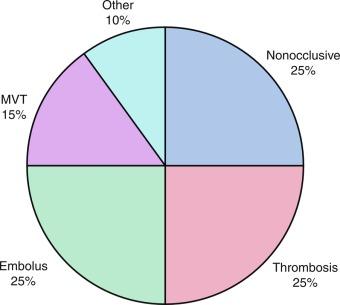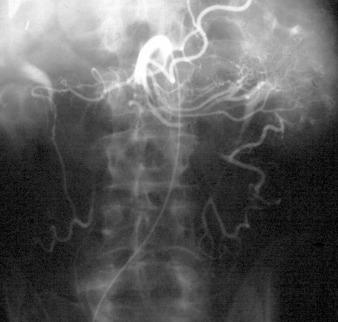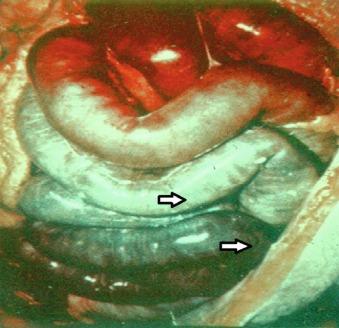Physical Address
304 North Cardinal St.
Dorchester Center, MA 02124
Mesenteric vascular disease can be characterized as acute or chronic, symptomatic or asymptomatic. Severe acute intestinal ischemia results from sudden symptomatic reduction in intestinal blood flow of sufficient magnitude to result potentially in intestinal infarction. Acute ischemia of the small bowel, colon, and liver may result from mesenteric arterial occlusion (embolus or thrombosis), mesenteric venous occlusion, and/or nonocclusive processes, particularly vasospasm. Dissections of the superior mesenteric artery (SMA) or celiac artery, either in association with cystic medial degeneration of the arteries or as a complication of an aortic dissection, may also result in acute intestinal ischemia.
Approximately 25% of all cases of acute mesenteric ischemia are due to emboli to the SMA, 25% of cases are due to thrombosis of preexisting atherosclerotic lesions, and the remaining 50% are due to a variety of other etiologies ( Fig. 25.1 ).

Mesenteric emboli can originate from left atrial or ventricular mural thrombi or from cardiac valvular lesions. Mesenteric artery embolism is most often associated with cardiac dysrhythmias such as atrial fibrillation, global myocardial dysfunction with poor ejection fraction, or discrete hypokinetic regions produced by previous myocardial infarction (MI). About 15% of SMA emboli lodge at the origin of the SMA, however, the majority lodge 3 to 10 cm distally in the tapered segment of the SMA just past the origin of the middle colic artery ( Fig. 25.2 ). More than 20% of emboli to the SMA are associated with concurrent emboli to another arterial bed. Intestinal ischemia due to embolic arterial occlusion can be compounded by reactive mesenteric vasospasm, further reducing collateral flow and exacerbating the ischemic insult.

Thrombosis of the SMA or the celiac artery is usually associated with preexisting high-grade stenoses. Many of these patients have histories consistent with chronic mesenteric ischemia (CMI), including postprandial pain, weight loss, and “food fear.” SMA thrombosis can be regarded as a complication of untreated chronic intestinal ischemia. The SMA plaque likely progresses slowly to a critical stenosis over years until thrombosis occurs. Unlike embolic occlusions, thrombosis of the SMA generally occurs flush with the aortic origin of the vessel. Acute mesenteric ischemia or thrombosis is also an uncommon (< 1%) but serious complication of cardiac surgery, with a reported mortality rate of greater than 50% in most series. Presumably, the nonpulsatile perfusion delivered by most extracorporeal circuits allows severely stenotic visceral vessels to occlude while the patient is on cardiopulmonary bypass. Identified risk factors for this complication include prolonged cross-clamp times, use of intraaortic balloon counterpulsation, low cardiac output syndromes, blood transfusion, triple-vessel disease, coronary artery disease (CAD), and peripheral artery disease (PAD).
Acute mesenteric ischemia, whether the underlying cause is embolic or thrombotic, may eventually lead to intestinal infarction while isolated mesenteric artery dissection rarely results in intestinal infarction ( Fig. 25.3 ). Hypoxia and hypercarbia that occur during flow interruption, and reperfusion injury once intestinal blood flow is restored, all contribute to tissue loss.

Reperfusion injury is believed to be mediated principally by activation of the enzyme xanthine oxidase, and recruitment and activation of circulating polymorphonuclear leukocytes (PMNs). The mechanism of injury likely involves production of oxygen-derived free radicals by xanthine oxidase, which then causes profound local tissue injury through lipid peroxidation, membrane disruption, and increased microvascular permeability. The ischemic endothelium recruits PMNs in an autocrine and paracrine manner by secreting chemotactic cytokines (such as tumor necrosis factor [TNF]-α, interleukin [IL]-1, and platelet-derived growth factor [PDGF]) that perpetuate further damage to the reperfused tissue. Once activated, PMNs degranulate, releasing myeloperoxidase, collagenases, and elastases that further injure already ischemic and vulnerable tissue. Activation of this endogenous inflammatory cascade is not restricted to the injured organ and may also have deleterious systemic effects, with cardiac, pulmonary, and other organ system dysfunction.
The mortality rate for occlusive acute mesenteric ischemia generally exceeds 70% in most series. Occlusive acute intestinal ischemia resulting from SMA embolism has a more favorable prognosis than that resulting from SMA thrombosis. Survival following acute intestinal ischemia due to SMA thrombosis is rare. The more favorable prognosis associated with embolism is attributable to the location at which most emboli lodge in the SMA (distal to the origin of the middle colic artery). This allows perfusion of the proximal intestine via the middle colic and jejunal artery branches. Thrombotic occlusion of the SMA, however, usually occurs proximal to the middle colic artery, and therefore completely interrupts midgut arterial perfusion in patients with a poorly developed celiac artery or inferior mesenteric artery (IMA) collateral flow.
Spontaneous mesenteric artery dissections (SMADs) are distinct from nonspontaneous dissections because there is no inciting event (e.g., trauma, aortic dissection). Isolated dissection of the SMA or celiac artery occur when a SMAD is not caused by an underlying diagnosed vascular disorder.
Although SMADs are infrequent, they are recognized more frequently with the increased use of modern cross-sectional imaging. As of 2017, there were approximately 200 cases of isolated celiac artery dissection and 250 cases of SMAD reported in the English-language literature with an additional 622 cases of SMAD reported in the Chinese literature. SMAD patients are predominantly male (> 80%), have a mean age of 50 to 60 years, and often suffer from comorbid conditions, including hypertension and hyperlipidemia.
Become a Clinical Tree membership for Full access and enjoy Unlimited articles
If you are a member. Log in here